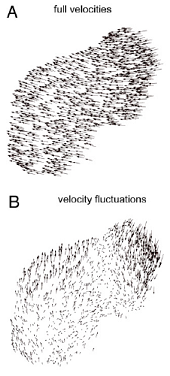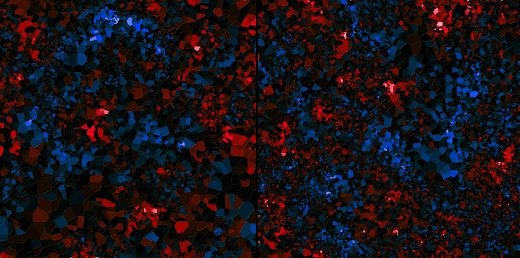Scale Invariance
 The research on starling murmurations resulted in another interesting observation. The flocks were found to have high order parameters - that is, the birds' velocities were mostly oriented in the same direction. (A sample reconstruction of a flock's velocities is shown in Figure A on the right)1 But even so, different areas of the flock fluctuate away from the average flock velocity; a plot of these fluctuations is shown in Figure B.
The research on starling murmurations resulted in another interesting observation. The flocks were found to have high order parameters - that is, the birds' velocities were mostly oriented in the same direction. (A sample reconstruction of a flock's velocities is shown in Figure A on the right)1 But even so, different areas of the flock fluctuate away from the average flock velocity; a plot of these fluctuations is shown in Figure B.
We might think of these fluctuations as 'sub-flocks.' For instance, there appears to be a sub-flock on the upper right side of the flock in Figure B. We can calculate a quantity called the correlation length which may be thought of as the average size of these sub-flocks. Surprisingly, the starling research found that the correlation length is proportional to the size of the flock - there are scale-free correlations. Though this evidence is tentative, this observation suggests a number of interesting consequences:
- If each bird is truly only aware of its neighbors, the sub-flocks can be expected to behave like an independent flock (though there may be boundary effects). So we expect the sub-flocks to have their own fluctuations with an average size given by the same ratio. In this sense, a flock acts like a fractal.
- Suppose we 'blur our eyes' so that a group of nearby birds appears as one bird. After this blurring (or renormalization), a flock of 100,000 birds may look like a real flock of 1,000 birds in many respects.
- Even large flocks have proportionately large sub-flocks which might grow to change the direction of the whole flock. So local changes in velocity (perhaps to avoid a predator or obstacle) may cascade upwards to affect the whole flock.
We might wonder if our new model exhibits these scale-free correlations. Note that since the interaction between the birds is independent of density in our model, the correlation length must indeed be proportional to the size of the flock if we only consider flocks with the same number of birds. What is more interesting is scale invariance as the number of birds varies.
We have demonstrated that our model undergoes a continuous phase transition to ordered flocking as the noise decreases. From the general theory of continuous phase transitions, if we consider flocks at the critical point where the order just begins to increase, the flock will indeed have scale-free correlations. But in the starling observations, the flocks had high order parameters - they were not at a finely-tuned critical point.

Above are two sample plots of velocity fluctuations in the new model. These are Voronoi tesselations where each cell contains one bird. The lighter a cell is, the more a bird's velocity deviates from the average velocity. The red and blue colors distinguish the two directions a bird can turn away from the average velocity.
Both of these samples were taken for ordered flocks with order parameters exceeding 90%. On the left there are 6,400 birds and on the right there are 25,600. Hopefully the statistical similarity under a change of scale is evident from the two images. We have in fact calculated the correlation length explicitly over a large number of samples, confirming it grows nearly proportionally to the size of the flock (though it is not clear whether this continues to be true as the size increases without bound). Such behavior is not anticipated theoretically and is a subject of further study.